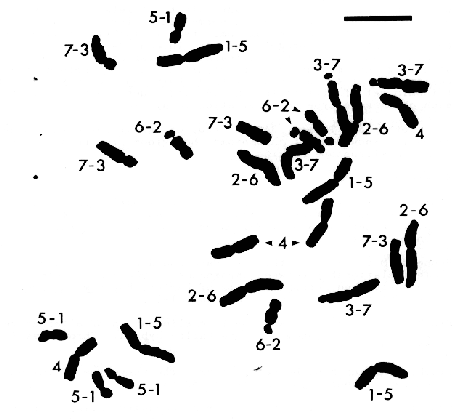

Plant Breeding Institute
Maris Lane, Trumpington
Cambridge CB2 2LQ, England. "R"
Tetaploid Tuleen 346 was produced by germinating 100 seeds of the diploid for 3 days at 20 C and immersing them for 5h in continuously aerated and stirred 0.1% w/v colchicine solution in 1.5% v/v aqueous dimethyl sulfoxide in the light. Under 10 plants survived and 52 seeds in total were set, of which 17 gave tetraploid seedlings and 33 gave diploid seedings.
When grown in glasshouses at Trumpington, Tetraploid Tuleen 346 was stouter, but shorter than its diploid. Ears selfed in winter were sterile, but ears selfed in summer were fertile, though less so than those of tetraploid Sultan barley grown with it.
Diploid Tuleen 346, produced by N.A. Tuleen in 1970-72 and named by Finch and Bennett (1982), is a triple interchange homozygote with T1-5v, T2-6y and T3-7d, all in the variety, Bonus. The changed karyotype allows identification of each chromosome in single cells purely by size and arm ratio, which is impossible in normal barley. Finch and Bennett (1982) described the karyotype of haploids and diploids in detail. In unsquashed haploid metaphases, all seven chromosomes in single cells can be identified correctly with a high degree of probability solely from relative chromosome volumes obtained from reconstructions of serial sections viewed in the electron microscope (Bennett, Smith, Ward and Finch, 1982). Even in squashed metaphases of haploids, diploids, and tetraploids, the seven chromosome types are easily distinguishable from one another except for occasional confusion between chromosomes T1-5v and T2-6y and, when its secondary constriction is unclear, T3-7d (Figure 1)

Reconstructed barley karyotypes have proved valuable in several ways such as correcting the idiogram of normal barley (Tuleen, 1973; Künzel, 1976) and locating mutable sites (Nicoloff, Rieger and Michaelis, 1979). Diploid Tuleen 346 has further made possible detailed chromosome position studies in barley (Bennett, 1981) and identification of eliminated chromosomes in single mitoses of embryos and endosperms in Hordeum hybrids (Finch, 1983).
Tetraploid Tuleen 346 offers the possibility of extending such studies to higher ploidy levels within barley and in hybrids. The ability it confers to identify chromosome types in single cells should facilitate study of chromosome behaviour in tetraploids. Thus all meiotic bivalents were identified at diakinesis in diploid Tuleen 346 from their relative DNA amounts (Bennett et al., 1982). It should be possible to identify more univalents, trivalents and quadrivalents at metaphase I in single cells of 4× Tuleen 346 than in normal 4× barley. Identification of dosages of each chromosome type in individual gametophyte cells, zygotes and progeny of 4× Tuleen 346 should also be possible and lead to increased understanding of processes affecting chromosome number stability in tetraploid barley. Pollination of 4× Tuleen 346 with H. bulbosum should yield both a trisomic set of diploid Tuleen 346 and clues to any effects of each chromosome type on elimination in hybrids.
Tetraploid Tuleen 346 is thus of great potential value in extending knowledge of chromosome behaviour in both light and electron microscope studies.
References:
Bennett, M.D. 1981. The spatial order of barley chromosomes. In: Barley Genetics IV, eds. M.J.C. Asher, R.P. Ellis, A.M. Hayter and R.N.H. Whitehouse; pp. 751-757. Edinb. Univ. Press.
Bennett, M.D., J.B. Smith, J.P. Ward and R.A. Finch. 1982. The relationship between chromosome volume and DNA content in unsquashed metaphase cells of barley, Hordeum vulgare cv. Tuleen 346. J. Cell Sci. 56:101-111.
Finch, R.A. 1983. Tissue-specific elimination of alternative whole parental genomes in one barley hybrid. Chromosoma 88: 386-393.
Finch, R.A. and M.D. Bennett. 1982. The karyotype of Tuleen 346 barley. Theor. Appl. Genet. 62:53-58.
Künzel, G. 1976. Indications for a necessary revision of the barley karyogramme by use of translocations. In: Barley Genetics IV, eds. M.J.C. Asher, R.P. Ellis, A.M. Hayter and R.N.H. Whitehouse; pp. 275-281. Edinb. Univ. Press.
Nicoloff, H., R. Rieger and A. Michaelis. 1979. Deletion clustering in specific chromosome segments of Hordeum vulgare and Vicia faba. Biol. Zbl. 98:527-535.
Tuleen, N.A. 1973. Karyotype analysis of multiple translocation stocks of barley. Can. J. Genet. Cytol. 15:267-273.